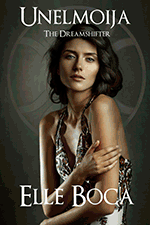Luxury Travel Review

New book highlights craft chocolate, shops, makers
By Elena del Valle
Photos by Gary Cox*

Bean to Bar Chocolate by Megan Giller
I have had chocolate in a number of forms and locations ranging from exotic and improbable such as a safari lodge and mundane such as my kitchen. I have sampled supermarket milk chocolate bars and dark chocolate gourmet bars, foreign and domestic. Over the years my preference has migrated from garden variety milk chocolate to the more flavorful options offered by specialty brands and artisan vendors. For some time I have been a fan of single origin chocolate bars, especially the plain dark chocolate ones layered with flavors.
My most recent chocolate experiences were enhanced manifold by Bean to Bar Chocolate America’s Craft Chocolate Revolution (Storey Publishing, $19.95), a new book by Megan Giller. Thanks to her detailed descriptions, I became much more aware of the diversity of the domestic craft chocolate movement and dozens of bean to bar makers. The 231-page hardcover book published this year features color photos, color illustrations and chocolate recipes.

Bean to Bar chocolate from Uganda grown and crafted in Africa
My favorite part of reading her book was the gourmet experiences that followed from preparing her recipe for Water-Based Drinking Chocolate (from Aubrey Lindley, co-owner, Cacao). I also tried the Cocoa Tea (from Miss Choco) made with roasted nibs and water, although that was less to my liking. Once I procured the chocolate bars the Water-Based Drinking Chocolate was a cinch. Like the Cocoa Tea the recipe calls for only two ingredients, chocolate (or roasted nibs) and boiling water.
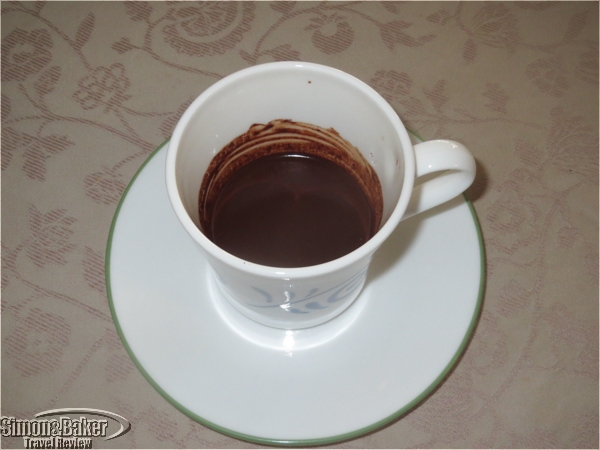
A few ounces of chocolate melted in a little hot water highlighted the qualities of each type we tasted.
For the Water-Based Drinking Chocolate we sampled four chocolate bar varieties, an organic and sustainably produced bar purchased at the supermarket; a bean to bar 70 percent single origin from Uganda made by De Villiers Artisan Chocolate near Paarl, South Africa; and a half and half blend (all we had available were partial bars) of single origin bean to bar Honduras The Lost City 72 percent and Dominican Republic Duarte 70 percent from Castronovo Chocolate from Stuart, Florida.
The beverage made with the supermarket bar was so awful we threw it out without finishing the serving. The Ugandan beverage tasted better although it was lumpy and had a medium to mild flavor, nothing extraordinary. The texture, even after whipping it twice with a small whisk, was lumpy. In defense of the makers it was past its expiration date. It was a good thing that we first tried the recipe with the Castronovo chocolates because we might not have sampled further otherwise.
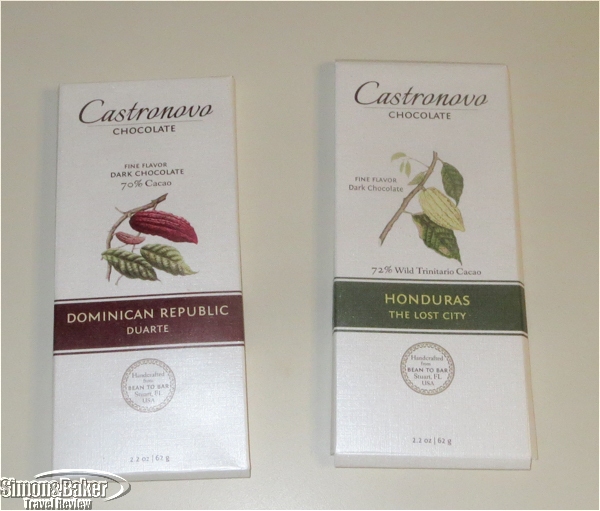
The Castronovo chocolate bars were our favorites for the chocolate beverage.
The Castronovo blend was delightful, dark and rich with a hint of smokiness and flavors that lingered on the palate. Later, I bought more of the Dominican Republic Duarte, my favorite of the two available at the small shop where I purchased them, planning another Water-Based Drinking Chocolate made with those bars. Also, I want to sample more domestic bean to bar chocolates and plan tastings, maybe even try some of the other recipes in the book.

Megan Giller, author, Bean to Bar Chocolate
Giller, a Brooklyn resident, is a food writer, specializing in New York City and Austin, Texas. She writes Chocolate Noise, a blog. Giller’s chocolate knowledge shines throughout the book and her enthusiasm is contagious. She shares information on the craft movement, the people behind the chocolates from the farms to the makers and their approach to purchasing cacao beans, roasting, processing and making mostly single origin chocolate, mainly with only a limited number of ingredients. She also addresses history, equipment, labels, sustainable practices and pricing. There is a list of her favorite bean to bar makers in the back of the book.
*Book photos: Storey Publishing

How big and beautiful cinema camera bag performed on the go
Article and photos by Aaron Lubarsky

The Cineluxe Backback 24
The Cineluxe Backback 24 by Tenba (Tenba, 75 Virginia Road, North White Plains, New York 10603, +1 914 347 3300, www.tenba.com, info@tenba.com) is a simple, large, lightweight backpack bag, made in China, designed for professional cinema cameras and electronic news gathering (ENG) rigs. On the road it was a non-nonsense, durable, weather-resistant bag that solved a specific problem: how to best carry a large fully built (with all the camera components assembled) camera rig on my back.

The backpack straps
It improved my efficiency in the field. The doctor bag style opening was a refreshing design innovation, allowing the camera to remain fully assembled and ready to go, which is a huge convenience for run-and-gun style filming or when time is a factor.

The interior of the Tenba Cinelux Backpack 24
The bag is large (13.5 wide by 24 tall by 14.25 deep, inches), but surprisingly nimble. Weighing eight pounds it was practical for quick moves from location to location, thanks to a comfortable harness and straps, and weathered tough conditions thanks to a body armor base panel.

A closer look at the compartments
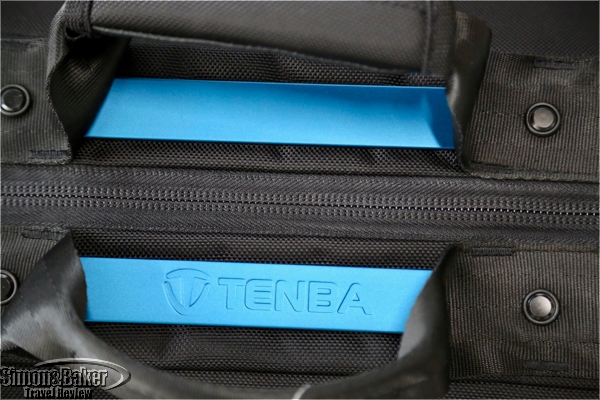
The handles are reinforced
The two side pockets didn’t open entirely because they were designed to hold shotgun mics, matte boxes, and flags. For that purpose they performed well, but there wasn’t an easily accessible pocket for small items like my wallet or cellphone. It’s not that kind of bag.


Color coded padded wraps
And it’s not the kind of heavy, solid bag I would check-in at the airport or load up with lots of accessories. It is too big for lean and small camera set-ups. It has the elegant touches I have liked on other Tenba bags, including attractive blue metal bands engraved with the Tenba name and a leather trimmed handle.
To hybrid or not to hybrid, a camera bag dilemma
Article and photos by Aaron Lubarksy

The Tenba 21 Hybrid Roller
I really wanted to love the Tenba 21 Hybrid Roller (Tenba, 75 Virginia Road, North White Plains, New York 10603, +1 914 347 3300, www.tenba.com, info@tenba.com). On paper it’s the perfect camera bag: a solid, versatile, roller bag that I can also throw on my back. On the road its performance was mixed. It was a terrific bag with a couple of small but maddening flaws that drove me a little nuts on a recent shoot.

The Hybrid Roller offered a generous amount of storage space.
The Hybrid Roller, made in China, offered a generous amount of storage space, flexibility, and elegance. It had plenty of zippers and inner pockets, including a removable padded camera insert. It comfortably held everything I needed for a recent DSLR shoot, including my sound gear and a laptop. The interior dimensions of the bag were 12 wide by 17 tall by 7 deep, in inches. It had a handy drop-in tripod carrier which was a nice (and space-efficient) touch. If I wanted security, this bag had me covered with two built in locking mechanisms: a steel security cable and lock plus an integrated TSA (Transportation and Security Administration) approved zipper lock. Like other Tenba bags I have used, the roadie 21 was durable, weather resistant and a cut-above the competition in terms of luxury and style. I liked it for carry-on luggage.

The Hybrid Roller single exterior pocket
As someone who likes to keep things organized I love pockets and compartments, so a minor gripe I had with this bag was the lack of an easily accessible exterior pockets (for a boarding pass, water bottle, kindle, snack, chargers). The Hybrid Roller only had only one exterior pocket, which made the bag look sleek and discrete, but limited its practicality for travel. While the exterior could have used more pockets, the interior delivered on that front and provided a safe home to my gear.

The built-in steel security cable and lock
However, the backpack part just didn’t cut it for me. The bag lacked the kind of padding and contours that are a natural feature in most bags designed to be backpacks I have used. When on my back it was uncomfortable and rigid, the straps felt thin, and the bag felt heavy and bulky (it weighed 11 pounds empty). It was my primary bag on a recent three day travel shoot from New York City to Utah and Idaho. By day two I was only using it as a roller bag.

The integrated TSA approved zipper lock
I was hoping as a hybrid I could easily switch from backpack to roller bag, but when I had the backpack area opened, the straps would get caught in the wheels, ruining my flow (and the straps). Bottom line: to use it as a roller bag, I needed to first put away the backpack set-up (or cut the straps). For my colleagues who want a hybrid bag, and have the patience to withstand some discomfort and set-up, this bag packed a punch, but I recommend committing to the roadie 21 roller bag, not the hybrid version.
Our brief visit to Blyde River Canyon, South Africa
By Elena del Valle
Photos by Gary Cox

The Berlin Falls in Mpumalanga, South Africa
On a recent safari trip to South Africa earlier this year we had an opportunity to visit the Blyde River Canyon. One of the owners of the Belgrace Boutique Hotel, who also owned a tour company, invited us to a half day visit of the area as part of our transfer from his hotel to our safari property. Visiting the canyon required us to leave extra early. Our efforts were rewarded as the parking lot at the first of our stops was nearly deserted, except for curio vendors setting up for the day and staff cleaning the public bathrooms.

It was a little hazy, but the view from the God’s Windows lookout was breathtaking.
According to SouthAfrica.net, the 29,000 hectare Blyde River Canyon Nature Reserve is carved out of red sandstone and is one of South Africa’s most remarkable geological features. Salient areas of the “green canyon” we saw were the Three Rondavels or Three Sisters, God’s Window and Bourke’s Luck Potholes.

Over time the flow of water carved out circular “potholes” in the limestone of the valley.

The river flows rapidly just above the potholes.

The same photo with a long exposure filter to smooth the water (just for fun)
The further along we progressed the more tourists we encountered, including several buses packed with travelers speaking foreign tongues. There were also more curio vendors in make shift structure and later inside a building. In lieu of lunch we snacked on locally produced cashews, macadamia nuts and dried fruits from a plastic container our tour escort brought with him. There were also chilled juices and water.

The Three Rondavels were our final stop as we made our way through the canyon.

The series of attractions were part of the Blyde River Canyon Nature Reserve
The added attractions were worth the extra effort and time. Although we had few moments to spare for much beyond photos and quick rest stops we enjoyed the sights and the opportunity to see yet another beautiful natural wonder in the vast country full of natural treasures.
Camp Jabulani elephant experience
By Elena del Valle
Photos by Gary Cox

Jabulani, the camp’s namesake, at The First Meeting in May 2017
On our first visit to Camp Jabulani, a Five Star lodge near South Africa’s famed Kruger National Park, in 2008 we met some of the house elephants who had been raised or rescued by humans. After the young Jabulani, born in 1997, was abandoned by his elephant relatives when he became stuck in the mud the owners of the privately owned Big Five Kapama Reserve opened their hearts and their pockets to adopt him. In 2004, they established Camp Jabulani. When a herd of elephants in neighboring Zimbabwe was marked for slaughter they intervened, relocating the herd to their property.

Left to right: Matipedza Tigere, elephant manager, and another staff member at The First Meeting, part of The Camp Jabulani Elephant Experience

A staff member showed us how to feed the pachyderms pellets via the elephant’s trunk.
On that visit we met the whole herd, watched the staff tuck them in for the night and, most memorable of all, went elephant back riding. Earlier this year only weeks before our return, Camp Jabulani stopped offering elephant back rides. We wondered how the changes would affect our visit. We need not have worried as we had a comfortable stay and rewarding elephant experience at the luxury lodge.

A closeup look at the elephant’s huge molars
“Camp Jabulani is a rather special lodge as it was established with the sole purpose of providing and income to look after Jabulani and a herd of elephants rescued from Zimbabwe in 2002,” Christo Rachmann, general manager, explained. “Currently the cost of looking after our elephants is around R450 000,00 per month. By visiting Camp Jabulani guests are actively contributing to the well-being of these magnificent animals.”

A closeup of the elephant’s huge eye and very long lashes was surprisingly difficult to photograph.
During our two night in stay in May 2017 we had The Camp Jabulani Elephant Experience. The day we arrived we had The First Meeting, part of The Camp Jabulani Elephant Experience. We spent a few minutes with Jabulani and another even larger young male. Under the watchful eye of Matipedza Tigere, elephant manager, we fed them pellet snacks, touched their skin and took photos. They smelled us with the tip of their trunk, quickly picked the pellets directly from our hands and let us run our hand along their side with surprising calm. Jabulani wrapped his trunk around my waist and dragged me gently yet firmly to one side (it was impossible to hold my position) until the elephant manager intervened.

The elephant manager explained how an elephant’s foot carries its heavy body yet makes soft sounding footsteps.
Such nearness could give the false impression that elephants are easy to approach. Many safari trips have taught me that is far from true. I have a deep respect for the gentle giants. The elephants and the elephant manager’s relaxed demeanor reassured me as did his instructions. Tigere, a native of Chinhoyi, Zimbabwe, had 18 years of experience, and had a Field Guides Association of Southern Africa (FGASA) Level One Theory rating. He had been at Camp Jabulani since 2008. If he said it was safe to interact with the two huge creatures I believed him.
Because of the rescued elephants unique background the herd developed a positive atypical family structure. The staff explained that there are strong ties between male and female animals, and clearly established matriarchs have assumed responsibility for all infants, their own (five babies were born to the herd), as well as that of new orphans. The babies that have arrived in the last five years were successfully introduced to the herd with minimal human intervention. According to promotional materials, the managers and owners of Camp Jabulani planned to continue to rescue and rehabilitate elephants in need.

The youngest member of the herd was curious about our vehicle when we came to watch them play in the water
The following day at noon we waited for the 15 semi-tame elephants of the house herd to enter the water hole, hoping they would bathe. That was the In Their Element activity, also part of The Camp Jabulani Elephant Experience. We watched from our vehicle and they watched us back, curious. When playful elephants approached our vehicle our guide reversed, avoiding contact. A couple of times he revved the loud engine to make a particularly nosy elephant retreat. When we asked if there was danger he explained that wasn’t the case. They were curious about us and wanted to explore. The problem was that if an elephant brushed the new vehicle with its trunk it would damage the paint.

These younger members of the herd wrestled and played while we watched

On the way to their pens for the night, the elephants paraded past our sun downer spot.
We watched the herd feed and interact. A number of elephant handlers sat around on the ground. We waved hello and they waived back. They called the youngest elephant to one side where they fed her a special extra nutritious blend from a bucket. For whatever reason the herd didn’t go in the water that afternoon. I didn’t mind much. Watching them so calm and playful was enough for me. A few minutes later the handlers rose to their feet, calling the herd away. As we drove back to Camp Jabulani I smiled. Our stay at the luxury property had been a pleasure, and seeing the elephants in close proximity the way we had was one of the main reasons.
At Sabi Sabi Bush Lodge excellent game viewing
By Elena del Valle
Photos by Gary Cox

Watching the sun come up with the Southern Pride was one of the highlights of our trip.
On a recent safari trip to South Africa we stayed at Sabi Sabi Earth Lodge and Sabi Sabi Bush Lodge (Sabi Sabi Private Game Reserve, Sabi Sand Wildtuin, Mpumalanga, South Africa, lodge +27 13 7355-656, Sabi Sabi head office +27 11 447-7172, www.sabisabi.com, res@sabisabi.com). The two five star properties, members of the National Geographic Unique Lodges of the World, were family owned and located within the 6,000 hectare Sabi Sabi Private Game Reserve, which is within the Sabi Sand Reserve. It in turn is a Big Five reserve adjacent (without fences) to the famous Kruger National Park. At Bush Lodge we stayed in comfortable and spacious rooms, and we especially enjoyed the game viewing in a private vehicle and spa massage.
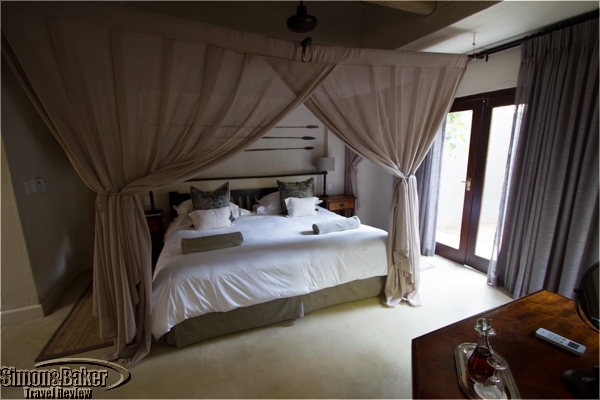
Our beds had color coordinated mosquito netting, a change from the customary white netting
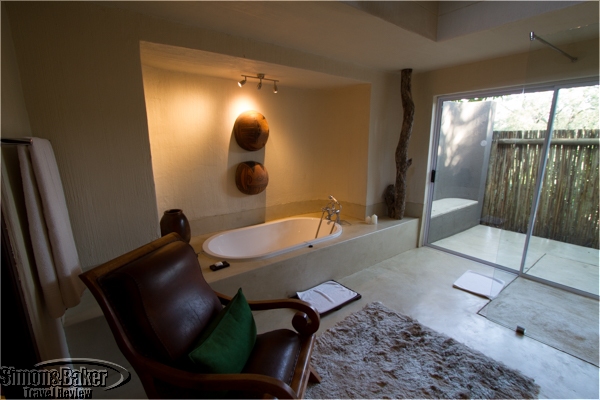
Our spacious bathrooms had a bathtub as well as indoor and outdoor showers.
During our visit, Stefan Schoeman, general manager lodges, Sabi Sabi, assisted us with camera related issues with speed and ease. We were glad to have our cameras in good working order since we saw the Big Five at Bush Lodge. On our first of two game drives we saw four of the Big Five. We drove around in an open Toyota LandCruiser in search of wildlife and interesting natural features to observe. We were delighted to have the game vehicle and Francois Rosslee, ranger, and Dollen Nkosi, tracker, to our selves. We have found that private game drives enhance our bush experience. So it was at Bush Lodge. Francois, a friendly man fond of his job, had been our ranger at Earth Lodge, where we had shared the vehicle with two other guests. That facilitated our arrival and check-in at its sister lodge.

The main deck had several lookout points over the dry river
Francois was a Full Trails Guide Level 2 of the Field Guides Association of Southern Africa (FGASA) with six years of experience and a seemingly inexhaustible supply of energy. Dollen had attained a FGASA Tracker Level 2 and had been with Sabi Sabi for nine years.

Our ranger Francois Rosslee (right) horsing around with Lawrence Mkansi, assistant lodge manager and head ranger
At Bush Lodge we saw the following mammals: buffalo, common duiker, dwarf mongoose, elephants, hippopotamus, kudu, leopard, lion, scrub hare, side-striped jackal, spotted hyena, tree squirrel, vervet monkey, warthog, waterbuck, white rhinoceros; insects: African monarch butterfly, Broad-bordered grass yellow, blue pansy, scarlet tip; trees and shrubs: jackalberry, knobthorn, leadwood, buffalo-thorn, silver cluster-leaf, large-leaved rock fig, greenthorn, and tamboti; and plants: wild cucumber, fannel weed, feather-top chloris, herringbone, and thatching yellow.
We saw or heard the following bird: African fish eagle, African grey hornbill, African scops-owl, bateleur eagle, Burchell’s starling, Cape glossy starling, Cape turtle dove, crested barbet, crested francolin, dark-capped bulbul, emerald-spotted wood-dove, fork-tailed drongo, go-away-bird, greater blue-eared glossy starling, green woodhoopoe, magpie shrike, rattling cisticola, redbilled oxpecker, southern yellow-billed hornbill, spotted thick-knee, Swainson’s spurfowl, laughing dove, Flappet lark.

One of the lions

Approaching a sighting in progress
The 25 room family friendly property owned by Hilton and Jacqui Loon had two swimming pools, an amply stocked boutique shop (branded clothing, jewelry, coffee table books, art, accessories), Amani Health Spa, and EleFun Children’s Centre. Although the game reserve and lodge opened in 1979, during 2015 and 2016 the public areas and rooms were completely refurbished.

Our rooms had a sitting area, desk and small outdoor patio facing the dry riverbed.
Our 80 square meter well appointed Luxury Suites faced a dry riverbed. They were comfortably furnished (I especially appreciated the large pleasantly firm bed), quiet, cool when it was hot outside and warm when it was cold. Like its sister property it had a number of amenities such as coffee machine, mini refrigerator and perfume scented Charlotte Rhys toiletries as well as thoughtful touches like a convenient location for electric plugs on the desk and pre-stamped postcards.

We had excellent closeup sightings of Cape buffalo, one of the Big Five.

A young kudu male with horns just developing

Stefan Schoeman, general manager, was a gracious host.
Meals were buffet style, with a made to order station, in an open air dining room in the main area. We sat at the table of our choice, where staff took our beverage orders. We enjoyed a delicious dinner, including Lamb neck, grilled meat and venison (gemsbock) in the boma (African open air enclosure).

The pool deck had a view of the river


One of my favorite activities was a massage treatment with Tarren, the spa manager and Francois’s girlfriend. Had there been more time I would have explored the spa menu further. The excellent Big Five game viewing and spa treatment made our stay at Bush Lodge special. I would return and recommend it to friends seeking a family and group friendly stay in the Sabi Sand Reserve.


